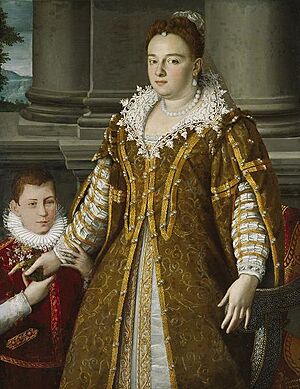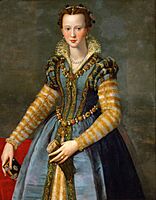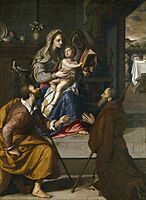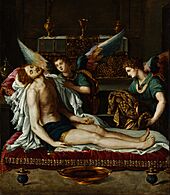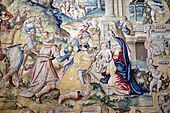Alessandro Allori facts for kids
Quick facts for kids
Alessandro Allori
|
|
|---|---|
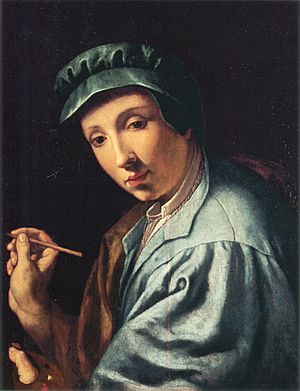
Self-portrait by Alessandro Allori, ca. 1555
|
|
| Born | 31 May 1535 Florence, Italy
|
| Died | 22 September 1607 (aged 72) Florence, Italy
|
| Known for | Painting |
| Movement | Mannerism |
Alessandro Allori (born May 31, 1535, died September 22, 1607) was an Italian painter. He belonged to the late Mannerist art movement in Florence, Italy. He is known for his detailed and polished paintings.
Contents
Biography
Alessandro Allori was born in Florence, Italy. When he was young, his father passed away. A famous painter named Agnolo Bronzino, a family friend, then raised and taught Alessandro art. Bronzino was a master of the Mannerist style. Both Alessandro and his son, Cristofano, sometimes used "Bronzino" in their names later on. Alessandro also traveled to Rome from 1554 to 1560 to study art. He even studied human bodies to understand anatomy better for his paintings.
Allori became very successful in his career. He led one of the two most important art workshops in Florence during the late 1500s. The other workshop was run by Santi di Tito. In 1573, Allori became the First Consul of the Accademia del Disegno. This was a very important art academy. In 1581, he was put in charge of the Arazzeria Medicea. This was Florence's official workshop for making tapestries.
Allori also worked with a team of artists led by Giorgio Vasari. They decorated the Studiolo of Francesco I, a special room for Duke Francesco I. Allori painted four panels for this room. These included a Banquet of Cleopatra and portraits of Cosimo I de' Medici and Eleanor of Toledo. From 1578 to 1582, he worked at the Medici Villa di Poggio a Caiano. There, he finished a large painting called Tribute to Caesar. This painting had been started by Andrea del Sarto many years before. Allori changed his painting style to match del Sarto's work. This showed his respect for the older artist.
Some art experts describe Allori's paintings as very precise and almost like statues. However, other experts, like Simona Lecchini Giovannoni, praise his work. She notes that Allori made his figures seem alive by adding realistic details. He often included plants, flowers, furniture, and fabrics in his paintings. These details help viewers connect with the art.
Allori had many students who learned from him. Some of his main students were Giovanni Maria Butteri and Giovanni Bizzelli. Other students included Cristofano dell'Altissimo and Aurelio Lomi. Alessandro Allori was also the father of another famous painter, Cristofano Allori (1577–1621).
The famous writer and artist Giorgio Vasari wrote about Allori in his book, Lives of the Most Excellent Painters, Sculptors, and Architects. Vasari said that the relationships between artists like Jacopo Pontormo, Bronzino, and Allori were like family. He saw them as an artistic "dynasty." Allori is seen as one of the last great Florentine painters. His style was strongly rooted in the art traditions of Tuscany. Later artists in Florence were more influenced by the Baroque style from other parts of Italy.
Main works
Here are some of Alessandro Allori's important paintings:
- Portrait of a Young Man (1561; Ashmolean Museum, Oxford)
- Christ and the Samaritan Woman (Altarpiece, 1575, Santa Maria Novella, now Prato)
- Road to Calvary (1604, Rome)
- Dead Christ and Angels, (Museum Fine Arts, Budapest)
- Portrait of Piero de Médici, (São Paulo Art Museum, São Paulo)
- Pearl Fishing (1570–72, Studiolo of Francesco I, Palazzo Vecchio, Florence)
- Susanna and the Elders (202 × 117 cm, Musée Magnin, Dijon)
- Allegory of Human Life
- The Miracle of St. Peter Walking on Water
- Venus and Cupid, (Musée Fabre, Montpellier)
- Additions to Andrea del Sarto's Tribute to Caesar (1582; Villa di Poggio a Caiano)
In 2006, a journalist named Sir Charles Wheeler returned an original Alessandro Allori painting. He gave it back to the Gemäldegalerie, Berlin in Germany. He had received the painting in 1952, but only later realized it was a valuable artwork. It was likely taken during World War II. The painting is a small portrait, possibly of Eleonora (Dianora) di Toledo de' Medici.
Gallery
See also
 In Spanish: Alessandro Allori para niños
In Spanish: Alessandro Allori para niños


